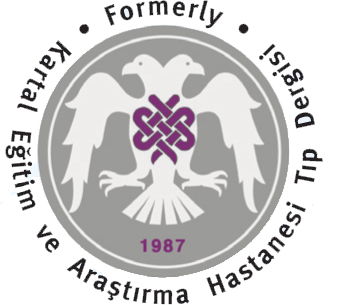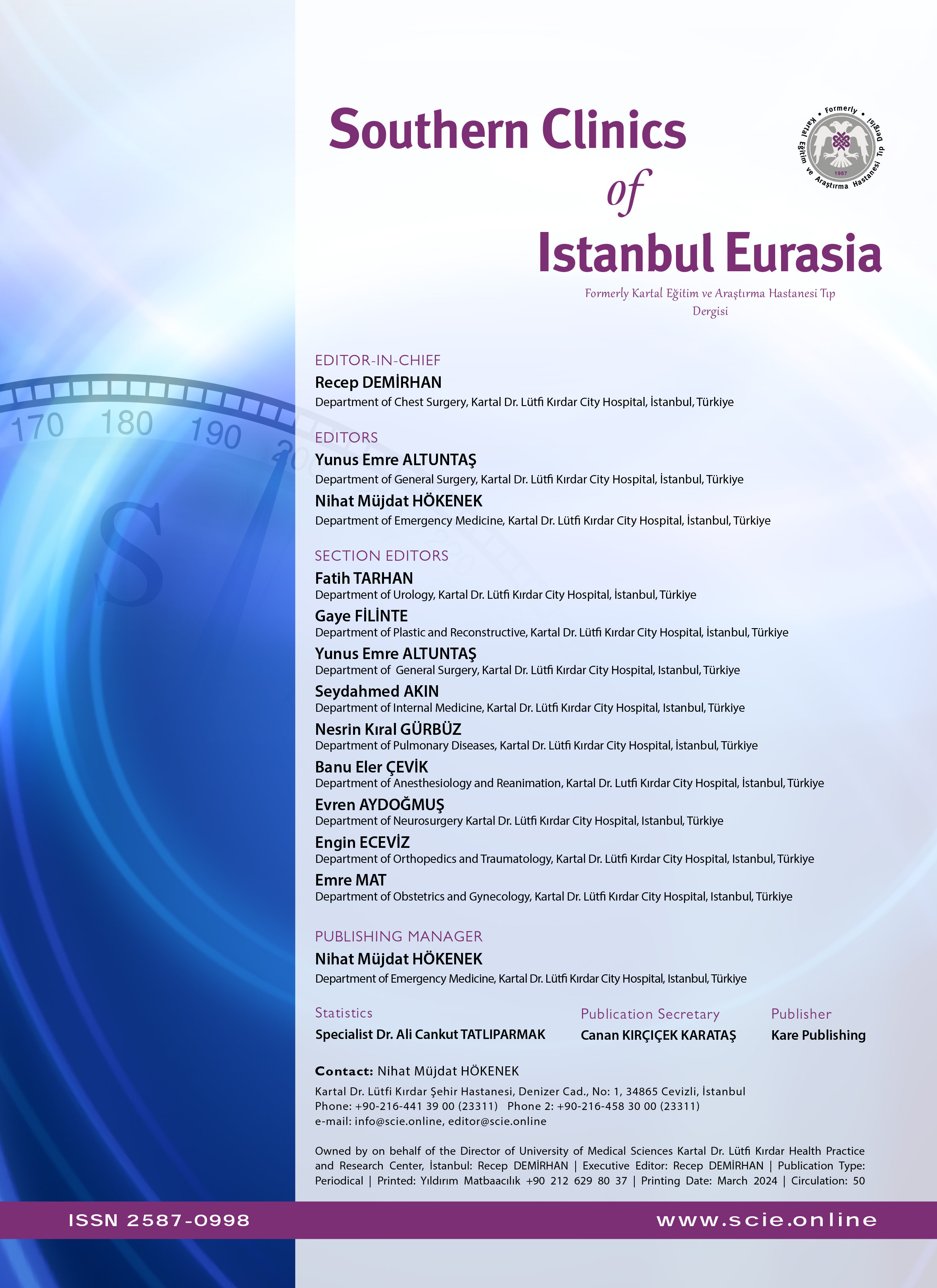Retrospective analysis of the clinical and pathological states of multiple myeloma patients
Özlem Nuray Türe, Taflan Salepçi, Haluk Sargın, Yener Koç, Ali YaylaDr. Lütfi Kırdar Kartal Training and Research Hospital, Department of Internal Medicine 1, İstanbul, TurkeyOBJECTIVE: The aim of this study is to evaluate the clinical and pathological states of Multiple Myeloma (MM) patients under the 1st Internal Medicine Department follow-up and to present results of the treatment.
METHODS: We analyzed retrospectively 21 patients diagnosed as MM according to SWOG criteria during the years 1996-2002. The so-called SWOG criteria are bone marrow plasmacytosis, monoclonal gammopathy of the serum or urine, radiological confirmation of bone lesions and confirmation of the plasmacytoma with tissue biopsy. Eight of the patients were female and 13 were male. The mean age was 63,7±7 (47-75) yrs. At the time of diagnosis, to evaluate the performance of the patients we used Karnofsky Performance Scale.
RESULTS: The general performance was 60% (medium). The presenting symptoms were fatigue 48%, back pain 60%, groin pain 55%. The physical examination and laboratory tests showed paleness 43%, severe anemia (Hb<8,5 gr) 33%, augmentation of the creatinin (Cr>2 mg/dl) 14% and the uric acid level (>8 mg/dl) 5%, lowered albumin level (<3 gr/dl) 33%, raised globulin level (>4,5 gr/dl) 52,3%. There were no patients whose serum calcium level was 12 mg/dl. Radiologic modalities revealed lytic bone lesions in 12 patients. The most frequently seen M protein type was IgG. Two cases were diagnosed as nonsecretuary MM. 4 of the patients were at Stage IA (19%), 11 were at Stage IIA (52,7%), 1 were at Stage IIB (4,7%), 3 were at Stage IIIA (14,2%), 2 were at Stage IIIB (10%) at the time of diagnosis. 16 (76%) patients were given VAD therapy (vincristine 0,4 mg per day 1, 2, 3, 4 days c.i.v. infusions, doxorubicine 9 mg/m2 per day 1, 2, 3, 4 days c.i.v. infusions, dexamethasone 40 mg/dl 1, 2, 3, 4, 9, 10, 11, 12, 17, 18, 19, 20 days p.o.). This therapy course was repeated as 28 days cycles. Eight patients were given MP therapy (melphalan 6 mg/m2 per day p.o. 1 -7 days, prednisolone 75 mg/day p.o. 1 -7 days). We repeated this therapy monthly. Three (14%) patients took MP therapy first and afterwards VAD therapy was started since progression had occurred. Ten (48%) patients had radiotherapy combined with chemotherapy because of the lytic bone lesions or compression of the spinal cord. Pamidronate was used to prevent hypercalcaemia and pathologic fractures. Neither fracture nore hypercalcaemia were seen. In one case adriamycine was changed into MP therapy because of its cardiotoxicity. The VAD therapy couldn't be used in 1 patient because of her pulmonary embolism history. Two (10%) cases had total remission and 6(29%) had partial remission. Seven (33%) were refractory to therapy. One case had been lost after the first MP therapy independent of MM (cardiac reasons). The therapies of the others are still continuing. The most frequent complications of therapy were bone marrow suppression 4(19%) patients and nausea, vomiting 3(14%) patients. One patient was lost because of acute renal failure. The mean life time expectancy was 27,6±4,2 (10-54) months. Patients diagnosed as MM were middle or older ages. At the time of diagnosis their performance were medium, respond to the therapy were good except two patients. Patients were remained remission about 6 months since the therapy had stopped than they showed progression.
CONCLUSION: Under 1st Internal Medicine Department of our hospital follow-up MM patients therapy response were resemble the other MM series. To prevent the hypercalcaemia and fractures due to lytic bone lesions disphosphonates were useful.
Multiple myelom tanısı ile takip ve tedavisi düzenlenen olguların klinik ve patolojik durumlarının retrospektif analizi
Özlem Nuray Türe, Taflan Salepçi, Haluk Sargın, Yener Koç, Ali YaylaDr. Lütfi Kırdar Kartal Eğitim ve Araştırma Hastanesi, 1. Dahiliye Kliniği, İstanbulAMAÇ: Çalışmanın amacı hastanemiz 1. İç Hastalıkları Kliniği'nce takip edilen multiple myelom tanısı almış hastaların klinik ve patolojik görünümlerini değerlendirmek ve tedavinin sonuçlarını belirlemekti.
YÖNTEMLER: 1996-2002 yılları arasında SWOG kriterlerine göre multiple myelom tanısı almış 21 hasta retrospektif olarak analiz edildi. SWOG kriterleri; kemik iliği plazmasitozisi, serum veya idrarda monoklonal gammapati, kemik lezyonlarının radyolojik olarak gösterilmesi ve plazmasitomun doku biyopsisinde gösterilmesiydi. Hastaların 8'i kadın, 13'ü erkekti. Yaşları 47 ile 75 arasında, ortalama 63,7±7 yıl idi. Başvuru sırasında hastaların performanslarını değerlendirmek için Karnofsky performans skalası kullanıldı.
BULGULAR: Genel olarak hastaların performansları orta (%60) idi. En yaygın başvuru nedenleri yorgunluk, halsizlik %48, sırt ağrısı %60 ve bel ağrısı %55 idi. Fizik muayene, laboratuar görünümleri ve radyolojik tetkikler sonucunda solukluk %43, ciddi anemi (Hb<8,5 gr) %33, kreatinin yüksekliği (Cr>2,0 mg/dl) %14, ürik asit yüksekliği (>8 mg/dl) %5, globulin yüksekliği (>4,5 gr/dl) %52,3, albumin düşüklüğü (3 gr/dl) %33 olarak bulundu. Serum kalsiyum düzeyi >12 mg/dl olan hasta yoktu. Kemikte litik lezyon 12 hastada saptandı. IgG proteini en yaygın görülen M protein tipiydi. İki olgu nonsekretuar multiple myelom tanısı aldı. Tanı anında hastaların 4'ü (%19) Evre IA, 11'i (%52,7) Evre IIA, 1'i (%4,7) Evre IIB, 3'ü (%14,2) Evre IIIA, 2'si (%10) Evre IIIB idi. 16 (%76) hastaya VAD tedavisi (Vincristin 0,4 mg/gün l, 2, 3, 4. günler iv. sürekli infüzyon, Doxorubucin 9 mg/m2/gün 1,2, 3, 4. günler iv. sürekli infüzyon, Dexamethasone 40 mg/gün l, 2, 3, 4, 9, 10, 11, 12, 17, 18, 19, 20. günler) uygulandı. Bu tedavi 28 günde bir tekrarlandı. Sekiz (%38) hastaya Melphalan+Prednisolone=MP (Melphalan 6 mg/m2/gün, Prednisolone 75 mg/gün 4 gün boyunca) uygulandı. Tedavi 4 haftada bir tekrarlandı. Üç (%14) hastaya önce MP tedavisi uygulandı. Progresyon görülünce VAD tedavisi verildi. On (%48) hastaya kemikteki litik lezyonlar veya spinal kord basısı nedeniyle kemoterapi ile birlikte radyoterapi uygulandı. Hiperkalsemi ve patolojik kırıklardan sakınmak için pamidronat kullanıldı. Hastaların hiçbirinde hiperkalsemi ve kırık görülmedi. Bir hastada adriamisinin kardiyotoksik doza ulaşması nedeniyle MP tedavisine geçildi. Bir hastada ise pulmoner emboli geçirmiş olması nedeniyle VAD protokolü uygulanamadı. Tam remisyon iki (%10) olguda, kısmi remisyon 6(%29) hastada gerçekleşti. Yedi (%33) hasta tedaviye refrakterdi. Bir hasta 1. kür MP tedavisinden sonra hastalıktan bağımsız (kardiak) nedenle kaybedildi. Diğer hastaların tedavisi halen devam etmektedir. Tedavinin en yaygın komplikasyonu kemik iliği supresyonu 4(%19) ve bulantı, kusma 3(%14) idi. Bir hasta akut böbrek yetmezliği nedeniyle kaybedildi. Yaşam süreleri 10 ile 54 ay arasında, ortalama 27,6±4,2 ay idi. Multiple myelom tanısı almış hastalar orta ve ileri yaş grubunda idi. Tanı anında genellikle performansları orta, tedaviye yanıtları 2 hasta dışında iyi idi. Hastalar ilaçlar kesildikten sonra ortalama 6 ay remisyonda kaldılar. Sonra progresyon gösterdiler.
SONUÇ: Hastanemiz l. İç Hastalıkları Kliniği'nde takip edilen multiple myelom olgularının tedaviye yanıtlarının diğer multiple myelom olgu serileri ile benzer olduğu görüldü. Hiperkalsemi ve litik kemik lezyonlarına bağlı kırık profilaksisinde pamidronat gibi disfosfonatların kullanımının faydalı olduğu düşünüldü.
Corresponding Author: Özlem Nuray Türe, Türkiye
Manuscript Language: Turkish



















